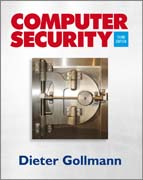
INDICE: 1. History of Computer Security. 1.1 The Dawn of Computer Security.1.2 1970s Mainframes. 1.3 1980s Personal Computers. 1.4 1990s Internet. 1.5 2000s The Web. 1.6 Conclusions The Benefits of Hindsight. 2. Managing Security.2.1 Attacks and Attackers. 2.2 Security. 2.3 Security Management. 2.4 Risk and Threat Analysis. 2.5 Further Reading. 2.6 Exercises. 3. Foundations of Computer Security. 3.1 Definitions. 3.2 The Fundamental Dilemma of Computer Security. 3.3 Data vs Information. 3.4 Principles of Computer Security. 3.5 The LayerBelow. 3.6 The Layer Above. 3.7 Further Reading. 3.8 Exercises. 4. Identification Components. 8.3 Access Decisions. 8.4 Managing Policies. 8.5 Task Dependent Access Rights. 8.6 Administration. 8.7 Further Reading. 8.8 Exercises. 9. Database Security. 9.1 Introduction. 9.2 Relational Databases. 9.3 Access Control. 9.4 Statistical Database Security. 9.5 Integration with the Operating System. 9.6 Privacy. 9.7 Further Reading. 9.8 Exercises. 10. Software Security. 10.1 Introduction. 10.2 Characters and Numbers. 10.3 Canonical Representations. 10.4 Memory Management. 10.5 Data and Code. 10.6 Race conditions. 10.7 Defences. 10.8 Further Reading. 10.9 Exercises. 11. Bell-LaPadula Model. 11.1 State Machine Models. 11.2 The Bell-LaPadula Model. 11.3 The Multics Interpretation of BLP. 11.4 Further Reading. 11.5 Exercises. 12. Security Models. 12.1 The Biba Model. 12.2 Chinese Wall Model. 12.3 The Clark-Wilson Model. 12.4 The Harrison-Ruzzo-Ullman Model. 12.5 Information-Flow Models. 12.6 Execution Monitors. 12.7 Further Reading. 12.8 Exercises. 13. Security Evaluation. 13.1 Introduction. 13.2 The Orange Book. 13.3 The rainbow Series. 13.4 Information TechnologySecurity Evaluation Criteria. 13.5 The Federal Criteria. 13.6 The Common Criteria. 13.7 Quality Standards. 13.8 An Effort Well Spent? 13.9 Summary. 13.10 Further Reading. 13.11 Exercises. 14. Cryptography. 14.1 Introduction. 14.2 Modular Arithmetic. 14.3 Integrity Check Functions. 14.4 Digital Structures. 14.5Encryption. 14.6 Strength of Mechanisms. 14.7 Performance. 14.8 Further Reading. 14.9 Exercises. 15. Authentication in Distributed Systems. 15.1 Introduction. 15.2 Key Establishment and Authentication. 15.3 Key Establishment Protocols. 15.4 Kerberos. 15.5 Public Key Infrastructures. 15.6 Trusted Computing Attestation. 15.7 Further Reading. 15.8 Exercises. 16. Communications Security. 16.1 Introduction. 16.2 Protocol Design Principles. 16.3 IP Security. 16.4 IPsecand Network Address Translation. 16.5 SSL/TLS. 16.6 Extensible AuthenticationProtocol. 16.7 Further Reading. 16.8 Exercises. 17. Network Security. 17.1 Introduction. 17.2 DNS. 17.3 Firewalls. 17.4 Intrusion Detection. 17.5 Further Reading. 17.6 Exercises. 18. Web Security.
- ISBN: 978-0-470-74115-3
- Editorial: John Wiley & Sons
- Encuadernacion: Rústica
- Páginas: 456
- Fecha Publicación: 17/12/2010
- Nº Volúmenes: 1
- Idioma: Inglés
